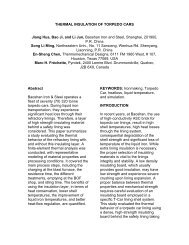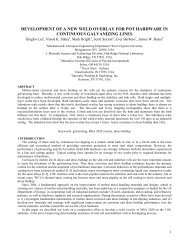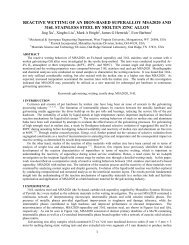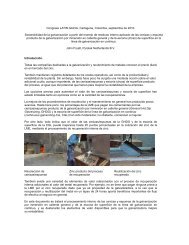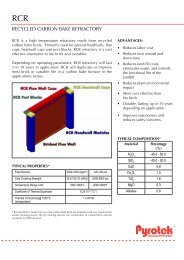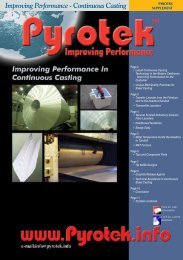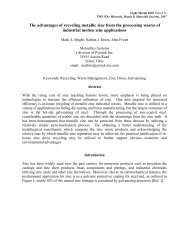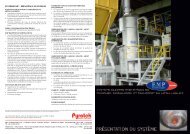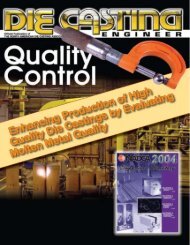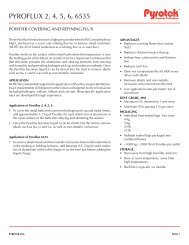improving performance in furnace melt treatment process - Pyrotek
improving performance in furnace melt treatment process - Pyrotek
improving performance in furnace melt treatment process - Pyrotek
Create successful ePaper yourself
Turn your PDF publications into a flip-book with our unique Google optimized e-Paper software.
Paul Campbell<br />
Market<strong>in</strong>g Manager<br />
Metaullics Systems<br />
Division<br />
In-Furnace Melt Treatment Process<br />
The<br />
Metaullics<br />
gas <strong>in</strong>jection<br />
pump is the<br />
product of<br />
choice<br />
where<br />
demagg<strong>in</strong>g is<br />
required.<br />
Page 6<br />
DEMAGGING WITH CHLORINE<br />
In order to produce foundry alloys,<br />
secondary s<strong>melt</strong>ers often use chlor<strong>in</strong>e gas<br />
to demag, degas, or both. Foundry alloys<br />
for sand, permanent mold, and die cast<strong>in</strong>g<br />
require low magnesium levels. Wrought<br />
alloys such as build<strong>in</strong>g materials,<br />
extrusions, beverage conta<strong>in</strong>ers,<br />
and a wide variety of other<br />
commonly recycled consumer<br />
products conta<strong>in</strong> substantially high<br />
levels of magnesium. To the extent<br />
possible, scrap is often blended<br />
based on pric<strong>in</strong>g, availability, and<br />
composition to meet or approach<br />
the magnesium specification for<br />
the material be<strong>in</strong>g produced. In<br />
many cases, however, the<br />
specification cannot be met by<br />
blend<strong>in</strong>g alone and s<strong>melt</strong>ers have<br />
found that gas <strong>in</strong>jection pumps are<br />
an effective tool to achieve the<br />
required result.<br />
Demagg<strong>in</strong>g efficiencies are<br />
dependent on thermodynamic and k<strong>in</strong>etic<br />
considerations. Under favorable<br />
conditions, magnesium can be removed<br />
from molten alum<strong>in</strong>ium alloys by add<strong>in</strong>g<br />
halogen compounds such as chlor<strong>in</strong>e. The<br />
reaction between magnesium and chlor<strong>in</strong>e<br />
occurs because there is a preferred<br />
chemical aff<strong>in</strong>ity at normal molten<br />
alum<strong>in</strong>ium operat<strong>in</strong>g temperatures.<br />
In accordance with the follow<strong>in</strong>g reactions,<br />
when gaseous chlor<strong>in</strong>e is <strong>in</strong>troduced <strong>in</strong>to<br />
molten alum<strong>in</strong>ium, alum<strong>in</strong>ium chloride is<br />
produced as a gaseous product (see<br />
equation below). When magnesium is<br />
present, the alum<strong>in</strong>ium chloride reactively<br />
decomposes to form magnesium chloride<br />
which rises to the surface where it can be<br />
removed by skimm<strong>in</strong>g. Favorable<br />
thermodynamics alone do not guarantee<br />
efficient magnesium removal. K<strong>in</strong>etic<br />
factors such as rate of mix<strong>in</strong>g, contact area,<br />
and concentrations will all have dramatic<br />
effects.<br />
2Al + 3Cl 2AlCl (1)<br />
2 3<br />
2AlCl + 3Mg 3MgCl + 2Al (2)<br />
3 2<br />
The follow<strong>in</strong>g graph represents typical<br />
demagg<strong>in</strong>g results <strong>in</strong> the production of<br />
foundry <strong>in</strong>got <strong>in</strong> a 75 ton <strong>furnace</strong> with a 38<br />
ton heel from the previous heat. Scrap<br />
conta<strong>in</strong><strong>in</strong>g high percentages of magnesium<br />
was charged <strong>in</strong>to the <strong>furnace</strong> while the<br />
pump was operat<strong>in</strong>g. The gas <strong>in</strong>jection<br />
pump was able to remove the magnesium<br />
at essentially the same rate that it was<br />
added to the <strong>furnace</strong>, ma<strong>in</strong>ta<strong>in</strong><strong>in</strong>g the alloy<br />
▲ ▲<br />
PYROTEK<br />
SUPPLEMENT<br />
with<strong>in</strong> the specification limit for the alloy<br />
be<strong>in</strong>g produced.<br />
It has always been necessary for chlor<strong>in</strong>ation<br />
technology <strong>in</strong> alum<strong>in</strong>ium recycl<strong>in</strong>g to meet<br />
rigorous environmental standards. Current<br />
MACT (Maximum Achievable Control<br />
Technology) standards <strong>in</strong> the U.S. have<br />
taken this requirement to an even higher<br />
level. Compared to other chlor<strong>in</strong>ation<br />
technologies, gas <strong>in</strong>jection pumps provide<br />
the safest and most efficient technology for<br />
accomplish<strong>in</strong>g this aspect of <strong>melt</strong><strong>in</strong>g and<br />
ref<strong>in</strong><strong>in</strong>g.<br />
When demagg<strong>in</strong>g is required, the Metaullics<br />
gas <strong>in</strong>jection pump is the product of choice<br />
due to its proven operat<strong>in</strong>g efficiency, low<br />
ma<strong>in</strong>tenance, rugged construction and<br />
reliability.<br />
METAULLICS GAS INJECTION<br />
PUMPS<br />
Advanced technology, with the<br />
revolutionary 6-barrel impeller design,<br />
achieves longer life, higher efficiencies,<br />
and reduced ma<strong>in</strong>tenance requirements.





